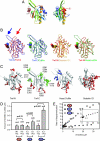Structural basis and evolutionary origin of actin filament capping by twinfilin
- PMID: 17360616
- PMCID: PMC1805582
- DOI: 10.1073/pnas.0608725104
Structural basis and evolutionary origin of actin filament capping by twinfilin
Abstract
Dynamic reorganization of the actin cytoskeleton is essential for motile and morphological processes in all eukaryotic cells. One highly conserved protein that regulates actin dynamics is twinfilin, which both sequesters actin monomers and caps actin filament barbed ends. Twinfilin is composed of two ADF/cofilin-like domains, Twf-N and Twf-C. Here, we reveal by systematic domain-swapping/inactivation analysis that the two functional ADF-H domains of twinfilin are required for barbed-end capping and that Twf-C plays a critical role in this process. However, these domains are not functionally equivalent. NMR-structure and mutagenesis analyses, together with biochemical and motility assays showed that Twf-C, in addition to its binding to G-actin, interacts with the sides of actin filaments like ADF/cofilins, whereas Twf-N binds only G-actin. Our results indicate that during filament barbed-end capping, Twf-N interacts with the terminal actin subunit, whereas Twf-C binds between two adjacent subunits at the side of the filament. Thus, the domain requirement for actin filament capping by twinfilin is remarkably similar to that of gelsolin family proteins, suggesting the existence of a general barbed-end capping mechanism. Furthermore, we demonstrate that a synthetic protein consisting of duplicated ADF/cofilin domains caps actin filament barbed ends, providing evidence that the barbed-end capping activity of twinfilin arose through a duplication of an ancient ADF/cofilin-like domain.
Conflict of interest statement
The authors declare no conflict of interest.
Figures




Similar articles
-
Mammalian twinfilin sequesters ADP-G-actin and caps filament barbed ends: implications in motility.EMBO J. 2006 Mar 22;25(6):1184-95. doi: 10.1038/sj.emboj.7601019. Epub 2006 Mar 2. EMBO J. 2006. PMID: 16511569 Free PMC article.
-
Structural conservation between the actin monomer-binding sites of twinfilin and actin-depolymerizing factor (ADF)/cofilin.J Biol Chem. 2002 Nov 8;277(45):43089-95. doi: 10.1074/jbc.M208225200. Epub 2002 Aug 30. J Biol Chem. 2002. PMID: 12207032
-
Two biochemically distinct and tissue-specific twinfilin isoforms are generated from the mouse Twf2 gene by alternative promoter usage.Biochem J. 2009 Jan 15;417(2):593-600. doi: 10.1042/BJ20080608. Biochem J. 2009. PMID: 18837697
-
Regulation of actin dynamics by Twinfilin.Curr Opin Cell Biol. 2025 Feb;92:102459. doi: 10.1016/j.ceb.2024.102459. Epub 2025 Jan 6. Curr Opin Cell Biol. 2025. PMID: 39765045 Review.
-
Control of actin filament dynamics at barbed ends by WH2 domains: from capping to permissive and processive assembly.Cytoskeleton (Hoboken). 2013 Oct;70(10):540-9. doi: 10.1002/cm.21124. Epub 2013 Aug 7. Cytoskeleton (Hoboken). 2013. PMID: 23843333 Review.
Cited by
-
Cofilin-1 and Other ADF/Cofilin Superfamily Members in Human Malignant Cells.Int J Mol Sci. 2016 Dec 22;18(1):10. doi: 10.3390/ijms18010010. Int J Mol Sci. 2016. PMID: 28025492 Free PMC article. Review.
-
Cytoskeleton-associated gelsolin responds to the midgut distention process in saline meal-fed Aedes aegypti and affects arbovirus dissemination from the midgut.FASEB J. 2024 Jul 31;38(14):e23764. doi: 10.1096/fj.202302684RR. FASEB J. 2024. PMID: 39042395 Free PMC article.
-
Molecular mechanism for inhibition of twinfilin by phosphoinositides.J Biol Chem. 2018 Mar 30;293(13):4818-4829. doi: 10.1074/jbc.RA117.000484. Epub 2018 Feb 7. J Biol Chem. 2018. PMID: 29425097 Free PMC article.
-
Heterodimeric capping protein is required for stereocilia length and width regulation.J Cell Biol. 2017 Nov 6;216(11):3861-3881. doi: 10.1083/jcb.201704171. Epub 2017 Sep 12. J Cell Biol. 2017. PMID: 28899994 Free PMC article.
-
Twinfilin is a nonprocessive depolymerase which synergizes with formin to dramatically accelerate actin filament uncapping by 300-fold.Proc Natl Acad Sci U S A. 2025 May 6;122(18):e2501078122. doi: 10.1073/pnas.2501078122. Epub 2025 Apr 28. Proc Natl Acad Sci U S A. 2025. PMID: 40294253
References
-
- Pollard TD, Blanchoin L, Mullins RD. Annu Rev Biophys Biomol Struct. 2000;29:545–576. - PubMed
-
- Pantaloni D, Le Clainche C, Carlier MF. Science. 2001;292:1502–1506. - PubMed
-
- Paavilainen VO, Bertling E, Falck S, Lappalainen P. Trends Cell Biol. 2004;14:386–394. - PubMed
-
- Nicholson-Dykstra S, Higgs HN, Harris ES. Curr Biol. 2005;15:R346–R357. - PubMed
-
- McGough AM, Staiger CJ, Min JK, Simonetti KD. FEBS Lett. 2003;552:75–81. - PubMed
Publication types
MeSH terms
Substances
Associated data
- Actions
LinkOut - more resources
Full Text Sources
Molecular Biology Databases
Research Materials
Miscellaneous

